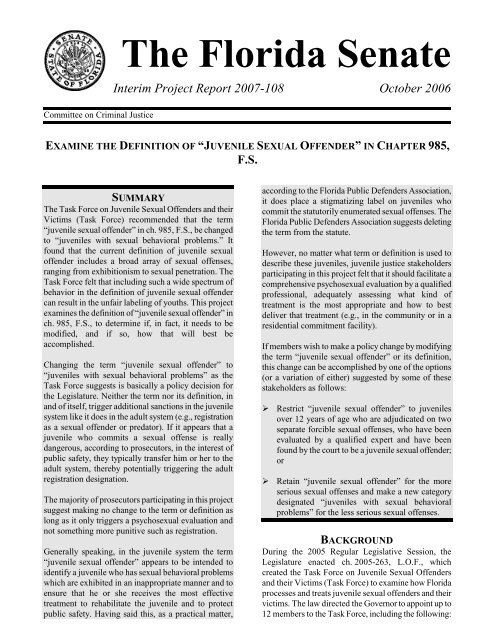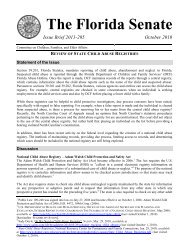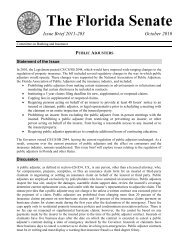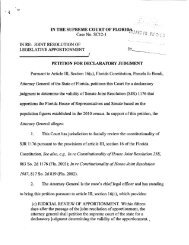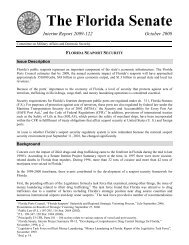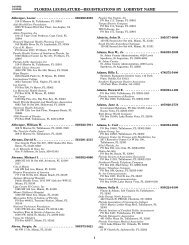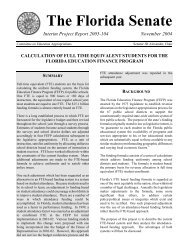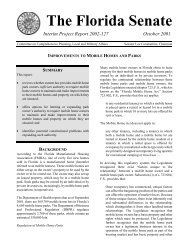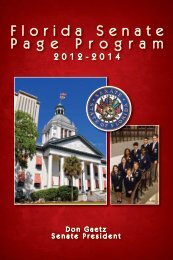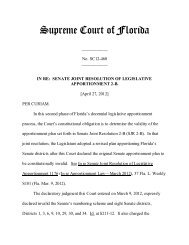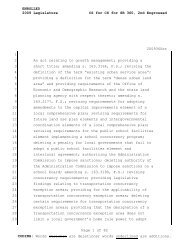"Juvenile Sexual Offender" in Chapter 985, FS - The Florida Senate
"Juvenile Sexual Offender" in Chapter 985, FS - The Florida Senate
"Juvenile Sexual Offender" in Chapter 985, FS - The Florida Senate
Create successful ePaper yourself
Turn your PDF publications into a flip-book with our unique Google optimized e-Paper software.
Committee on Crim<strong>in</strong>al Justice<br />
<strong>The</strong> <strong>Florida</strong> <strong>Senate</strong><br />
Interim Project Report 2007-108 October 2006<br />
EXAMINE THE DEFINITION OF “JUVENILE SEXUAL OFFENDER” IN CHAPTER <strong>985</strong>,<br />
F.S.<br />
SUMMARY<br />
<strong>The</strong> Task Force on <strong>Juvenile</strong> <strong>Sexual</strong> Offenders and their<br />
Victims (Task Force) recommended that the term<br />
“juvenile sexual offender” <strong>in</strong> ch. <strong>985</strong>, F.S., be changed<br />
to “juveniles with sexual behavioral problems.” It<br />
found that the current def<strong>in</strong>ition of juvenile sexual<br />
offender <strong>in</strong>cludes a broad array of sexual offenses,<br />
rang<strong>in</strong>g from exhibitionism to sexual penetration. <strong>The</strong><br />
Task Force felt that <strong>in</strong>clud<strong>in</strong>g such a wide spectrum of<br />
behavior <strong>in</strong> the def<strong>in</strong>ition of juvenile sexual offender<br />
can result <strong>in</strong> the unfair label<strong>in</strong>g of youths. This project<br />
exam<strong>in</strong>es the def<strong>in</strong>ition of “juvenile sexual offender” <strong>in</strong><br />
ch. <strong>985</strong>, F.S., to determ<strong>in</strong>e if, <strong>in</strong> fact, it needs to be<br />
modified, and if so, how that will best be<br />
accomplished.<br />
Chang<strong>in</strong>g the term “juvenile sexual offender” to<br />
“juveniles with sexual behavioral problems” as the<br />
Task Force suggests is basically a policy decision for<br />
the Legislature. Neither the term nor its def<strong>in</strong>ition, <strong>in</strong><br />
and of itself, trigger additional sanctions <strong>in</strong> the juvenile<br />
system like it does <strong>in</strong> the adult system (e.g., registration<br />
as a sexual offender or predator). If it appears that a<br />
juvenile who commits a sexual offense is really<br />
dangerous, accord<strong>in</strong>g to prosecutors, <strong>in</strong> the <strong>in</strong>terest of<br />
public safety, they typically transfer him or her to the<br />
adult system, thereby potentially trigger<strong>in</strong>g the adult<br />
registration designation.<br />
<strong>The</strong> majority of prosecutors participat<strong>in</strong>g <strong>in</strong> this project<br />
suggest mak<strong>in</strong>g no change to the term or def<strong>in</strong>ition as<br />
long as it only triggers a psychosexual evaluation and<br />
not someth<strong>in</strong>g more punitive such as registration.<br />
Generally speak<strong>in</strong>g, <strong>in</strong> the juvenile system the term<br />
“juvenile sexual offender” appears to be <strong>in</strong>tended to<br />
identify a juvenile who has sexual behavioral problems<br />
which are exhibited <strong>in</strong> an <strong>in</strong>appropriate manner and to<br />
ensure that he or she receives the most effective<br />
treatment to rehabilitate the juvenile and to protect<br />
public safety. Hav<strong>in</strong>g said this, as a practical matter,<br />
accord<strong>in</strong>g to the <strong>Florida</strong> Public Defenders Association,<br />
it does place a stigmatiz<strong>in</strong>g label on juveniles who<br />
commit the statutorily enumerated sexual offenses. <strong>The</strong><br />
<strong>Florida</strong> Public Defenders Association suggests delet<strong>in</strong>g<br />
the term from the statute.<br />
However, no matter what term or def<strong>in</strong>ition is used to<br />
describe these juveniles, juvenile justice stakeholders<br />
participat<strong>in</strong>g <strong>in</strong> this project felt that it should facilitate a<br />
comprehensive psychosexual evaluation by a qualified<br />
professional, adequately assess<strong>in</strong>g what k<strong>in</strong>d of<br />
treatment is the most appropriate and how to best<br />
deliver that treatment (e.g., <strong>in</strong> the community or <strong>in</strong> a<br />
residential commitment facility).<br />
If members wish to make a policy change by modify<strong>in</strong>g<br />
the term “juvenile sexual offender” or its def<strong>in</strong>ition,<br />
this change can be accomplished by one of the options<br />
(or a variation of either) suggested by some of these<br />
stakeholders as follows:<br />
‣ Restrict “juvenile sexual offender” to juveniles<br />
over 12 years of age who are adjudicated on two<br />
separate forcible sexual offenses, who have been<br />
evaluated by a qualified expert and have been<br />
found by the court to be a juvenile sexual offender;<br />
or<br />
‣ Reta<strong>in</strong> “juvenile sexual offender” for the more<br />
serious sexual offenses and make a new category<br />
designated “juveniles with sexual behavioral<br />
problems” for the less serious sexual offenses.<br />
BACKGROUND<br />
Dur<strong>in</strong>g the 2005 Regular Legislative Session, the<br />
Legislature enacted ch. 2005-263, L.O.F., which<br />
created the Task Force on <strong>Juvenile</strong> <strong>Sexual</strong> Offenders<br />
and their Victims (Task Force) to exam<strong>in</strong>e how <strong>Florida</strong><br />
processes and treats juvenile sexual offenders and their<br />
victims. <strong>The</strong> law directed the Governor to appo<strong>in</strong>t up to<br />
12 members to the Task Force, <strong>in</strong>clud<strong>in</strong>g the follow<strong>in</strong>g:
Page 2<br />
Exam<strong>in</strong>e the Def<strong>in</strong>ition of "<strong>Juvenile</strong> <strong>Sexual</strong> Offender" <strong>in</strong> <strong>Chapter</strong> <strong>985</strong>, F.S.<br />
a circuit court judge with at least one year’s experience<br />
<strong>in</strong> the juvenile division, a state attorney with at least<br />
one year’s experience <strong>in</strong> the juvenile division, a public<br />
defender with at least one year’s experience <strong>in</strong> the<br />
juvenile division, one representative of the Department<br />
of <strong>Juvenile</strong> Justice, two representatives of providers of<br />
juvenile sexual offender services, one member of the<br />
<strong>Florida</strong> <strong>Juvenile</strong> Justice Association, one member of<br />
the <strong>Florida</strong> Association for the Treatment of <strong>Sexual</strong><br />
Abusers, and one victim of a juvenile sexual offense.<br />
<strong>The</strong> Task Force held five meet<strong>in</strong>gs and a series of<br />
conference calls <strong>in</strong> 2005 to execute its duties and<br />
issued a f<strong>in</strong>al report of its f<strong>in</strong>d<strong>in</strong>gs and<br />
recommendations on January 18, 2006. One of its<br />
recommendations <strong>in</strong>cluded chang<strong>in</strong>g the term “<strong>Juvenile</strong><br />
<strong>Sexual</strong> Offender” <strong>in</strong> ch. <strong>985</strong>, F.S., to “<strong>Juvenile</strong>s with<br />
<strong>Sexual</strong> Behavioral Problems” so as not to unfairly label<br />
youths. <strong>The</strong> Task Force suggested us<strong>in</strong>g “juvenile sex<br />
offender” only for juveniles who are transferred to<br />
adult court for committ<strong>in</strong>g sexual offenses. 1<br />
Dur<strong>in</strong>g the 2006 Legislative Session, the <strong>Senate</strong><br />
Crim<strong>in</strong>al Justice Committee favorably reported CS/SB<br />
1454, which <strong>in</strong>corporated several of the Task Force<br />
recommendations, as well as authorized the<br />
cont<strong>in</strong>uation of the Task Force so it could further<br />
develop recommendations. <strong>The</strong> legislation did not<br />
make any changes to the juvenile sexual offender<br />
def<strong>in</strong>ition <strong>in</strong> ch. <strong>985</strong>, F.S. This bill failed to pass dur<strong>in</strong>g<br />
the session. It died <strong>in</strong> the <strong>Senate</strong> Judiciary Committee.<br />
METHODOLOGY<br />
Staff reviewed the f<strong>in</strong>d<strong>in</strong>gs and conclusions of the Task<br />
Force, studied relevant statutes and case law, and<br />
sought <strong>in</strong>put from knowledgeable stakeholders <strong>in</strong> the<br />
juvenile justice system, <strong>in</strong>clud<strong>in</strong>g prosecutors, public<br />
defenders, juvenile judges, private providers, and<br />
representatives from the Department of <strong>Juvenile</strong><br />
Justice.<br />
FINDINGS<br />
Current Law/Legislative History<br />
Currently, s. <strong>985</strong>.03(32), F.S., def<strong>in</strong>es a “juvenile<br />
sexual offender” as a juvenile who has been found to<br />
have committed a violation of any of the follow<strong>in</strong>g<br />
laws:<br />
1 <strong>Juvenile</strong> <strong>Sexual</strong> Offenders and <strong>The</strong>ir Victims: F<strong>in</strong>al<br />
Report, Task Force on <strong>Juvenile</strong> <strong>Sexual</strong> Offenders and<br />
their Victims, January 18, 2006, p. 5.<br />
‣ Ch. 794, F.S., proscrib<strong>in</strong>g sexual battery.<br />
‣ Ch. 796, F.S., proscrib<strong>in</strong>g prostitution.<br />
‣ Ch. 800, F.S., proscrib<strong>in</strong>g lewdness and <strong>in</strong>decent<br />
exposure.<br />
‣ s. 827.071, F.S., proscrib<strong>in</strong>g sexual performance<br />
by a child.<br />
‣ s. 847.0133, F.S., proscrib<strong>in</strong>g the provision of<br />
obscenity to m<strong>in</strong>ors.<br />
‣ Any felony violation of law or del<strong>in</strong>quent act<br />
<strong>in</strong>volv<strong>in</strong>g juvenile sexual abuse, which means any<br />
sexual behavior 2 that occurs without consent,<br />
without equality, or as a result of coercion.<br />
After an adjudicatory hear<strong>in</strong>g for a juvenile sexual<br />
offender, the court may either: (1) treat the offender as<br />
it would any other juvenile found to have committed a<br />
del<strong>in</strong>quent act (withhold adjudication and place the<br />
offender on probation or adjudicate the offender and<br />
impose probation or commitment 3 ); or (2) treat the<br />
offender as a juvenile sexual offender. Under the<br />
second option, the court, subject to specific<br />
appropriation, may:<br />
‣ Order an exam<strong>in</strong>ation of the juvenile sexual<br />
offender by a psychologist, therapist, or<br />
psychiatrist, if the offender has no recent history of<br />
a comprehensive assessment focused on sexually<br />
deviant behavior. 4 <strong>The</strong> report of this exam must<br />
<strong>in</strong>clude: (a) the offender’s account of the <strong>in</strong>cident<br />
and the official report of the <strong>in</strong>vestigation; (b) the<br />
offender’s offense history; (c) a multidiscipl<strong>in</strong>ary<br />
assessment of the offender’s sexually deviant<br />
behaviors by a psychologist, therapist, or<br />
psychiatrist; (d) an assessment of the offender’s<br />
family, social, educational, and employment<br />
situation; and (e) an assessment of the offender’s<br />
amenability to treatment and relative risk to the<br />
victim and community. 5<br />
2 <strong>The</strong> subsection further states that, “<strong>Juvenile</strong> sexual<br />
offender behavior ranges from noncontact sexual behavior<br />
such as mak<strong>in</strong>g obscene phone calls, exhibitionism,<br />
voyeurism, and the show<strong>in</strong>g or tak<strong>in</strong>g of lewd photographs<br />
to vary<strong>in</strong>g degrees of direct sexual contact, such as frottage,<br />
fondl<strong>in</strong>g, digital penetration, rape, fellatio, sodomy, and<br />
various other sexually aggressive acts.” s. <strong>985</strong>.03(32), F.S.<br />
3 ss. <strong>985</strong>.228 and <strong>985</strong>.231, F.S.<br />
4 s. <strong>985</strong>.231(3), F.S.<br />
5 s. <strong>985</strong>.231(3)(a) and (b), F.S.
Exam<strong>in</strong>e the Def<strong>in</strong>ition of "<strong>Juvenile</strong> <strong>Sexual</strong> Offender" <strong>in</strong> <strong>Chapter</strong> <strong>985</strong>, F.S. Page 3<br />
‣ Impose a juvenile sexual offender communitybased<br />
treatment alternative disposition. In order to<br />
utilize this alternative disposition, the court must<br />
first consider: (a) a proposed plan of the<br />
community-based treatment from the DJJ; (b)<br />
whether the offender and community will benefit<br />
from imposition of community-based treatment;<br />
and (c) the victim’s or victim’s family’s op<strong>in</strong>ion of<br />
whether the offender should receive communitybased<br />
treatment. Upon f<strong>in</strong>d<strong>in</strong>g that a communitybased<br />
alternative disposition is appropriate, the<br />
court may place the offender on community<br />
supervision for up to three years and impose<br />
conditions that require the offender to: (a) undergo<br />
outpatient juvenile sexual offender treatment; (b)<br />
rema<strong>in</strong> with<strong>in</strong> prescribed geographical boundaries;<br />
and (c) comply with all requirements of the<br />
treatment plan. If the offender violates any<br />
condition or if the court f<strong>in</strong>ds that the juvenile is<br />
fail<strong>in</strong>g to make satisfactory progress <strong>in</strong> treatment,<br />
the court may revoke the community-based<br />
treatment alternative and commit the offender to<br />
the DJJ. 6<br />
‣ Commit the juvenile sexual offender to the DJJ for<br />
placement <strong>in</strong> a juvenile sexual offender<br />
commitment program under s. <strong>985</strong>.308, F.S. This<br />
section authorizes the DJJ, subject to<br />
appropriation, to operate or contract for juvenile<br />
sexual offender commitment programs, which<br />
must <strong>in</strong>clude educational components, life<br />
management tra<strong>in</strong><strong>in</strong>g, substance abuse treatment,<br />
and <strong>in</strong>tensive psychological treatment.<br />
<strong>The</strong> statutory def<strong>in</strong>ition of juvenile sexual offender and<br />
the other provisions sett<strong>in</strong>g forth the policy and<br />
procedures govern<strong>in</strong>g these juveniles resulted from<br />
recommendations by the 1995 Task Force on <strong>Juvenile</strong><br />
<strong>Sexual</strong> Offenders and Victims of <strong>Juvenile</strong> <strong>Sexual</strong><br />
Abuse and Crimes. Dur<strong>in</strong>g the 1995 Regular<br />
Legislative Session, the Legislature passed a bill<br />
<strong>in</strong>corporat<strong>in</strong>g <strong>in</strong>to law some of these recommendations<br />
by the Task Force, which provided for a more effective<br />
and uniform response to juvenile sexual abuse. 7 This<br />
Task Force was created the year before by the<br />
Legislature to study the issue of juvenile sexual abuse<br />
and report back to the Legislature with f<strong>in</strong>d<strong>in</strong>gs and<br />
recommendations. 8 Accord<strong>in</strong>g to the 1995 Task Force,<br />
the def<strong>in</strong>ition of juvenile sexual offender mirrored the<br />
6 s. <strong>985</strong>.231(3), F.S.<br />
7 CS/HB 2023, Ch. 95-266, Laws of <strong>Florida</strong>.<br />
8 Section 111, ch. 94-209, Laws of <strong>Florida</strong>.<br />
one suggested by the National Task Force on <strong>Juvenile</strong><br />
Sex Offend<strong>in</strong>g <strong>in</strong> its 1993 revised report. 9<br />
Nowhere <strong>in</strong> these statutory provisions does it require<br />
the court to pronounce that a juvenile is a “juvenile<br />
sexual offender” for any purpose, <strong>in</strong>clud<strong>in</strong>g<br />
disposition, evaluation, treatment, or registration.<br />
However, if the court decides to reta<strong>in</strong> jurisdiction over<br />
the juvenile until he or she completes the residential<br />
sex offender commitment program up until the juvenile<br />
turns 21 years old, the court <strong>in</strong>cludes this f<strong>in</strong>d<strong>in</strong>g <strong>in</strong> its<br />
order. 10<br />
Unlike the adult system <strong>in</strong> which a sexual offense<br />
conviction requires the adult offender to register as a<br />
sexual offender or predator under the <strong>Florida</strong> <strong>Sexual</strong><br />
Predator Act <strong>in</strong> the juvenile system, an adjudication of<br />
del<strong>in</strong>quency for a sexual offense does not require such<br />
registration. However, if a juvenile is transferred to the<br />
adult system, and is sanctioned as an adult, rather than<br />
as a juvenile, then that youth is required to register as a<br />
sexual offender or predator under s. 943.0435 or<br />
s. 775.21, F.S. 11 Several prosecutors <strong>in</strong>dicated that they<br />
typically transfer the most serious juvenile sexual<br />
offenders <strong>in</strong>to the adult system where, if convicted,<br />
they will be <strong>in</strong>cluded on the sexual offender or predator<br />
registration list.<br />
Although the adult registration requirements are not<br />
applicable to a juvenile who is adjudicated del<strong>in</strong>quent<br />
for a sexual offense, the DJJ is required under ch. <strong>985</strong>,<br />
F.S., to notify the schools, parents or legal guardians of<br />
victims, and law enforcement agencies when a juvenile<br />
sexual offender returns to the community. 12<br />
Just as the adult registration requirements are not<br />
applicable to the majority of juveniles under 18 years<br />
of age, neither are the provisions of the <strong>Sexual</strong>ly<br />
Violent Predator Act (commonly known as the “Jimmy<br />
Ryce Act”), which allows for <strong>in</strong>voluntary civil<br />
9 Revised Report from the National Task Force on<br />
<strong>Juvenile</strong> Sex Offend<strong>in</strong>g, 1993.<br />
10 s. <strong>985</strong>.201, F.S.<br />
11 State v. J.M., 824 So. 2d 105 (Fla. 2002) (<strong>Florida</strong><br />
Supreme Court held that juveniles charged as adults but<br />
adjudicated as del<strong>in</strong>quents are not “crim<strong>in</strong>ally convicted”<br />
for purpose of sexual predator designation under the<br />
<strong>Sexual</strong> Predator Act.)<br />
12 s. <strong>985</strong>.04(3)(b), F.S., (notification also applies to<br />
juveniles under the DJJ custody with a known history of<br />
crim<strong>in</strong>al sexual behavior with other juveniles, or a<br />
juvenile who has pled guilty or nolo contendere to or been<br />
found to have committed certa<strong>in</strong> sexual offenses,<br />
regardless of adjudication) and <strong>985</strong>.308(1)(d), (6), F.S.
Page 4<br />
Exam<strong>in</strong>e the Def<strong>in</strong>ition of "<strong>Juvenile</strong> <strong>Sexual</strong> Offender" <strong>in</strong> <strong>Chapter</strong> <strong>985</strong>, F.S.<br />
commitment for sexually violent predators who are 18<br />
years of age or older. 13<br />
2005 Task Force<br />
Selected F<strong>in</strong>d<strong>in</strong>gs:<br />
‣ <strong>Juvenile</strong>s who sexually offend are not as<br />
aggressive or serious as their adult counterparts. 14<br />
‣ <strong>Juvenile</strong>s who sexually offend are generally<br />
responsive to treatment. Overall sex offense<br />
recidivism rate for juveniles is fairly low, typically<br />
between 5% and 15%. <strong>Juvenile</strong>s successfully<br />
complet<strong>in</strong>g sexual offender treatment have been<br />
found to have lower recidivism rates than their<br />
untreated counterparts. 15<br />
‣ Non-sexual del<strong>in</strong>quent behavior is typical among<br />
juveniles who sexually offend. 16<br />
‣ <strong>The</strong> recidivism rate for <strong>Florida</strong> juveniles released<br />
from high-risk residential sex offender treatment<br />
programs between July 1, 2002, and June 30,<br />
2004, ranged from 13% to 26% among the DJJ’s<br />
eight programs (and very few of the new offenses<br />
committed by these juveniles were sexual<br />
offenses). 17<br />
‣ Between 1998 and November 30, 2005, the DJJ<br />
referred 938 juveniles committ<strong>in</strong>g sexually<br />
del<strong>in</strong>quent acts for screen<strong>in</strong>g under the <strong>Sexual</strong>ly<br />
Violent Predator Act. Of these, only 34 were<br />
recommended for the civil commitment process,<br />
about 3.5 % of the total referrals. As of November<br />
30, 2005, n<strong>in</strong>e juveniles who were referred from<br />
the DJJ have been civilly committed to the<br />
<strong>Sexual</strong>ly Violent Predator treatment facility <strong>in</strong><br />
Arcadia, <strong>Florida</strong>. 18<br />
13 s. 394.912, F.S.<br />
14 National Center for <strong>Sexual</strong> Behavior of Youth. (July,<br />
2003). NCSBY Facts Sheet: What research shows about<br />
adolescent sex offenders [electronic version]. National<br />
Center on <strong>Sexual</strong> Behavior of Youth, No. 1, 1-3.<br />
15 Worl<strong>in</strong>g, J.R. & Curwen, T., (2000). Adolescent sexual<br />
offender recidivism: Success of specialized treatment and<br />
implications for risk prediction. Child Abuse and Neglect,<br />
24(7), 965-982.<br />
16 U.S. Department of Justice, Office of <strong>Juvenile</strong> Justice<br />
and Del<strong>in</strong>quency Prevention. (2001). <strong>Juvenile</strong>s who have<br />
sexually offended: OJJDP Report [electronic version].<br />
Office of <strong>Juvenile</strong> Justice and Del<strong>in</strong>quency Prevention.<br />
17 Program Accountability Measure report (2006), <strong>Florida</strong><br />
Department of <strong>Juvenile</strong> Justice.<br />
18 <strong>Juvenile</strong> <strong>Sexual</strong> Offenders and <strong>The</strong>ir Victims: F<strong>in</strong>al<br />
‣ <strong>The</strong> current def<strong>in</strong>ition of juvenile sexual offender<br />
<strong>in</strong>cludes a broad category of sexual offenses,<br />
rang<strong>in</strong>g from exhibition to penetration, which can<br />
unfairly label a juvenile with last<strong>in</strong>g consequences<br />
(restricted work<strong>in</strong>g and hous<strong>in</strong>g options),<br />
especially <strong>in</strong> light of the high success rates of<br />
treatment for these juveniles. 19<br />
‣ Comprehensive psychosexual evaluations are not<br />
required for all juveniles with a history of sexually<br />
del<strong>in</strong>quent or sexually <strong>in</strong>appropriate behavior.<br />
Because of <strong>in</strong>adequate funds, the current<br />
evaluations are not sufficient for properly<br />
facilitat<strong>in</strong>g the placement of these juveniles. 20<br />
‣ Requir<strong>in</strong>g such evaluations would help a qualified<br />
professional identify whether the sexually<br />
offend<strong>in</strong>g behavior was experimental, consensual,<br />
or predatory, thereby assist<strong>in</strong>g <strong>in</strong> the appropriate<br />
disposition and treatment. 21<br />
2006 Legislation<br />
<strong>The</strong> Legislature considered some of the f<strong>in</strong>d<strong>in</strong>gs and<br />
recommendations of the Task Force conta<strong>in</strong>ed <strong>in</strong><br />
CS/SB 1454. However, the legislation failed to pass<br />
dur<strong>in</strong>g the session. It would have implemented the<br />
follow<strong>in</strong>g changes:<br />
‣ Def<strong>in</strong>ed “Psychosexual evaluation,” to mean an<br />
evaluation by a qualified sexual offender<br />
practitioner, which addresses, at a m<strong>in</strong>imum, a<br />
juvenile sexual offender’s: (a) account of the<br />
<strong>in</strong>cident and the official report of the <strong>in</strong>vestigation;<br />
(b) sexual development and sexual del<strong>in</strong>quency<br />
history and treatment; (c) behavioral and<br />
del<strong>in</strong>quency history; (d) substance abuse and<br />
mental health history and treatment;<br />
(e) <strong>in</strong>tellectual, personality, trauma assessment;<br />
(f) physiological assessment if appropriate;<br />
(g) family, social, educational, and employment<br />
situation; (h) risk for committ<strong>in</strong>g a future act of<br />
sexual del<strong>in</strong>quency or physical harm to himself,<br />
herself, the victim, or other persons; (i) culpability<br />
assessment; (j) diagnosis; and (k) amenability to<br />
treatment, <strong>in</strong>clud<strong>in</strong>g treatment recommendations<br />
specific to his or her needs.<br />
Report, Task Force on <strong>Juvenile</strong> <strong>Sexual</strong> Offenders and<br />
their Victims, January 18, 2006, p. 9.<br />
19 <strong>Juvenile</strong> <strong>Sexual</strong> Offenders and <strong>The</strong>ir Victims: F<strong>in</strong>al<br />
Report, Task Force on <strong>Juvenile</strong> <strong>Sexual</strong> Offenders and<br />
their Victims, January 18, 2006, p.34-35.<br />
20 Id. at p. 26.<br />
21 Id. at 34.
Exam<strong>in</strong>e the Def<strong>in</strong>ition of "<strong>Juvenile</strong> <strong>Sexual</strong> Offender" <strong>in</strong> <strong>Chapter</strong> <strong>985</strong>, F.S. Page 5<br />
‣ Def<strong>in</strong>ed “Qualified <strong>Sexual</strong> Offender Practitioner”<br />
to mean a professional who is eligible to practice<br />
juvenile sexual offender therapy under<br />
s. 490.0145, F.S., or s. 491.0144, F.S., 22 and who:<br />
(a) possesses at least 55 hours of post-graduate<br />
degree cont<strong>in</strong>u<strong>in</strong>g education courses <strong>in</strong> one or<br />
more specified areas 23 and at least 2000 hours of<br />
post-graduate degree supervised practice <strong>in</strong> the<br />
evaluation and treatment of persons who have<br />
committed sexually del<strong>in</strong>quent acts; or (b) is<br />
directly supervised by a juvenile sexual offender<br />
therapist who satisfies the enumerated education<br />
and practice requirements.<br />
‣ Required the court to order the DJJ to conduct or<br />
arrange for a psychosexual evaluation of a juvenile<br />
sexual offender. 24<br />
22 Under ss. 490.0145 and 490.0144, F.S., only a person<br />
who is licensed as a psychologist, cl<strong>in</strong>ical social worker,<br />
marriage and family therapist, or mental health counselor<br />
and who possesses education and tra<strong>in</strong><strong>in</strong>g requirements<br />
specified <strong>in</strong> rule may practice juvenile sex offender therapy.<br />
See Rule 64B19-18.0025 (requir<strong>in</strong>g the follow<strong>in</strong>g for<br />
psychologists: coursework or tra<strong>in</strong><strong>in</strong>g <strong>in</strong> child behavior and<br />
development, child psychopathology, and child assessment<br />
and treatment and 30 hours tra<strong>in</strong><strong>in</strong>g <strong>in</strong> juvenile sex offender<br />
assessment and treatment); and Rule 64B4-7.007 (requir<strong>in</strong>g<br />
the follow<strong>in</strong>g for cl<strong>in</strong>ical social workers, marriage and<br />
family therapists, or mental health counselors: education and<br />
tra<strong>in</strong><strong>in</strong>g <strong>in</strong> child development and psychopathology,<br />
developmental sexuality, <strong>in</strong>teraction between sexuality,<br />
sexual arousal patterns, sexual dysfunctions, disorders, and<br />
deviancy, victim empathy, use/misuse of defense<br />
mechanisms, compulsivity management, social resilience,<br />
group therapy, and legal, ethical, and forensic issues <strong>in</strong><br />
juvenile sexual offender treatment, and 20 hours of<br />
cont<strong>in</strong>u<strong>in</strong>g education every two years <strong>in</strong> the aforementioned<br />
subjects).<br />
23 <strong>The</strong> areas of cont<strong>in</strong>u<strong>in</strong>g education specified by the bill<br />
are: DSM-IV diagnoses related to sexual offenders; etiology<br />
of sexual deviance; science-based sexually del<strong>in</strong>quent<br />
evaluation and risk assessment and treatment techniques; use<br />
of plethysmographs, visual reaction time, and polygraphs <strong>in</strong><br />
the evaluation, treatment, and monitor<strong>in</strong>g of juveniles who<br />
have committed sexually del<strong>in</strong>quent acts; evaluation and<br />
treatment of special populations; or legal and ethical issues<br />
<strong>in</strong> the evaluation and treatment of juveniles who have<br />
committed sexually del<strong>in</strong>quent acts.<br />
24 Fiscal impact estimated to be $530,000, based upon a<br />
cost of $1,200 per evaluation multiplied by 696 (the<br />
number of youth found to have committed sexual<br />
del<strong>in</strong>quency crimes <strong>in</strong> FY 2004-05) less $304,500 (the<br />
amount that the DJJ had available for evaluations <strong>in</strong> the<br />
same FY.)<br />
‣ Specified that the results and recommendations of<br />
the psychosexual evaluation are to be provided to<br />
the court <strong>in</strong> the offender’s predisposition report<br />
(PDR), if a PDR is completed, or <strong>in</strong> writ<strong>in</strong>g at least<br />
48 hours prior to the disposition hear<strong>in</strong>g, if a PDR<br />
is not completed.<br />
‣ Required a court to consider a juvenile sexual<br />
offender’s psychosexual evaluation prior to<br />
imposition of a community-based juvenile sexual<br />
offender treatment program.<br />
‣ Repealed the current law’s description of a<br />
comprehensive assessment focused on sexual<br />
deviancy, given the more comprehensive def<strong>in</strong>ition<br />
of “psychosexual evaluation” added by the bill to<br />
the chapter’s def<strong>in</strong>ition section.<br />
<strong>Juvenile</strong> <strong>Sexual</strong> Offense Data<br />
‣ In FY 2000-01, 1,897 youths (1,845 males and 52<br />
females) were referred to the DJJ for felony sexual<br />
offenses. That number decreased by 7% to 1,766<br />
(1,678 males and 88 females) <strong>in</strong> FY 2004-05. <strong>The</strong><br />
number of youths who actually received sanctions<br />
is much lower than the number of referred youths<br />
because many cases are non-filed or are nonjudicially<br />
diverted (see Table 1 below). 25<br />
Table 1: Case Outcomes for Youth Referred for<br />
Felony <strong>Sexual</strong> Del<strong>in</strong>quency, FY 2004-05<br />
Case Outcome Males Females<br />
Diverted 135 7<br />
Probation 403 14<br />
Commitment 223 9<br />
Transfer to Adult 117 2<br />
Total 878 32<br />
‣ In FY 2000-01, 202 youths (159 males, 43<br />
females) were referred to the DJJ for misdemeanor<br />
sexual offenses. That number decreased by 29% to<br />
143 (122 males, 21 females) <strong>in</strong> FY 2004-05.<br />
Similar to youths referred for felony sexual<br />
offenses, the number of youths who actually<br />
received sanctions for misdemeanor sexual<br />
offenses is much lower than the number of referred<br />
youths (see Table 2 below). 26<br />
25 Id. at p. 12.<br />
26 Id.
Page 6<br />
Exam<strong>in</strong>e the Def<strong>in</strong>ition of "<strong>Juvenile</strong> <strong>Sexual</strong> Offender" <strong>in</strong> <strong>Chapter</strong> <strong>985</strong>, F.S.<br />
Table 2: Case Outcomes for Youth Referred for<br />
Misdemeanor <strong>Sexual</strong> Del<strong>in</strong>quency, FY 2004-05<br />
Case Outcome Males Females<br />
Diverted 35 6<br />
Probation 37 1<br />
Commitment 8 1<br />
Transfer to Adult 0 0<br />
Total 80 8<br />
‣ In FY 2005-06, 1,767 youths (1,698 males, 69<br />
females) were referred to the DJJ for felony sexual<br />
offenses. That number is a decrease of 7% from<br />
FY 2000-01. <strong>The</strong> number of youths who actually<br />
received sanctions is much lower than the number<br />
of referred youths because many cases are nonfiled<br />
or are non-judicially diverted (see Table 3<br />
below). 27<br />
Table 3: Case Outcomes for Youth Referred for<br />
Felony <strong>Sexual</strong> Del<strong>in</strong>quency, FY 2005-06<br />
Case Outcome Males Females<br />
Diverted 138 9<br />
Probation 316 15<br />
Commitment 187 1<br />
Transfer to Adult 118 3<br />
Total 759 28<br />
‣ In FY 2005-06, 195 youths (146 males, 49<br />
females) were referred to the DJJ for misdemeanor<br />
sexual offenses. That number is a decrease of 3 %<br />
from FY 2000-01. Similar to youths referred for<br />
felony sexual offenses, the number of youths who<br />
actually received sanctions for misdemeanor<br />
offenses is much lower than the number of referred<br />
youths because many cases are non-filed or are<br />
non-judicially diverted (see Table 4 below). 28<br />
27 Source: Prelim<strong>in</strong>ary analysis of FY 2005-06 DJJ<br />
Del<strong>in</strong>quency Profile data, Office of Research and<br />
Plann<strong>in</strong>g, September 22, 2006.<br />
28 Id.<br />
Table 4: Case Outcomes for Youth Referred for<br />
Misdemeanor <strong>Sexual</strong> Del<strong>in</strong>quency, FY 2005-06<br />
Case Outcome Males Females<br />
Diverted 39 5<br />
Probation 46 18<br />
Commitment 5 2<br />
Transfer to Adult 2 0<br />
Total 92 25<br />
‣ In FY 2005-06, the eight most frequently referred<br />
sexual offenses were as follows: sexual battery by<br />
an offender under 18 years of age and a victim<br />
under 12 years of age (life felony); lewd and<br />
lascivious molestation by an offender under 18<br />
years of age and a victim under 12 years of age<br />
(second degree felony); lewd and lascivious<br />
molestation by an offender under 18 years of age<br />
and a victim 12 years of age or older but under 16<br />
years of age (third degree felony); lewd and<br />
lascivious battery on a victim 12 years of age or<br />
older but under 16 years of age (second degree<br />
felony); lewd and lascivious exhibition by an<br />
offender under 18 years of age and a victim under<br />
16 years of age (third degree felony); <strong>in</strong>decent<br />
exposure (first degree misdemeanor); lewd and<br />
lascivious conduct by an offender under 18 years<br />
of age and a victim under 16 years of age (third<br />
degree felony); and sexual battery on a victim 12<br />
years of age or older without his of her consent and<br />
no physical force likely to cause serious <strong>in</strong>jury<br />
(second degree felony) (see Table 5 below.) 29<br />
TABLE 5<br />
Most Frequent <strong>Sexual</strong> Offenses (FY 2005-06)<br />
Offense Statute Frequency<br />
(n)<br />
<strong>Sexual</strong> battery by 794.011(2)(b) 925<br />
offender under 18 and<br />
victim under 12<br />
Lewd Lascv molestation 800.04(5)(c)1. 624<br />
by offender under 18 and<br />
victim under 12<br />
Lewd Lascv battery 800.04(4)(a) 392<br />
victim is 12 up to 15<br />
Lewd Lascv molestation 800.04(5)(d) 386<br />
victim is up to 16<br />
Lewd Lascv exhibition by 800.04(7) 212<br />
person under 18 and<br />
victim under 16<br />
Indecent exposure 800.03 202<br />
29 Id. <strong>The</strong>re were 56 types of sexual offenses referred <strong>in</strong><br />
FY 2005-06.<strong>The</strong> total number of sexual offense referrals<br />
was 3,568.
Exam<strong>in</strong>e the Def<strong>in</strong>ition of "<strong>Juvenile</strong> <strong>Sexual</strong> Offender" <strong>in</strong> <strong>Chapter</strong> <strong>985</strong>, F.S. Page 7<br />
Lewd Lascv conduct by 800.04(6)(c) 187<br />
person under 18 and<br />
victim under 16<br />
<strong>Sexual</strong> battery victim 794.011(5) 119<br />
over 12 w/o physical<br />
force caus<strong>in</strong>g damage<br />
Total 3,047<br />
Interested Stakeholders Input<br />
<strong>The</strong> follow<strong>in</strong>g po<strong>in</strong>ts were made by various juvenile<br />
justice stakeholders participat<strong>in</strong>g <strong>in</strong> the project:<br />
‣ Numerous prosecutors said they have no problem<br />
with the current term “juvenile sexual offender” or<br />
its def<strong>in</strong>ition as long as the only consequence it<br />
triggers is a psychosexual evaluation. Currently, <strong>in</strong><br />
and of itself, the term or def<strong>in</strong>ition does not trigger<br />
registration sanctions <strong>in</strong> the juvenile system, unlike<br />
<strong>in</strong> the adult system. If prosecutors feel that a<br />
juvenile is dangerous and should be on the sexual<br />
offender registry, they can transfer that juvenile to<br />
the adult system and if convicted and sentenced as<br />
an adult, that juvenile will be subject to adult<br />
sanctions, <strong>in</strong>clud<strong>in</strong>g registration as a sexual<br />
offender or predator. On the other hand, if<br />
juveniles were required to be registered <strong>in</strong> the<br />
juvenile system as a result of this def<strong>in</strong>ition, then<br />
prosecutors felt that the def<strong>in</strong>ition would def<strong>in</strong>itely<br />
need to be narrowed.<br />
‣ One prosecutor who felt the current term and<br />
def<strong>in</strong>ition should be reta<strong>in</strong>ed, offered a suggestion<br />
for compromise if the overall consensus <strong>in</strong>dicates<br />
some change is necessary. <strong>The</strong> suggestion is to<br />
reta<strong>in</strong> the “juvenile sexual offender” designation<br />
for juveniles committ<strong>in</strong>g more serious sexual<br />
offenses, and make the other “juveniles with<br />
sexual behavioral problems” designation for<br />
juveniles committ<strong>in</strong>g less serious sexual offenses<br />
(maybe those who do not directly sexually batter or<br />
molest another child or animal). In the case of lewd<br />
and lascivious exposure, which does not <strong>in</strong>volve<br />
any direct contact with another child, make the<br />
“juvenile sexual offender” designation apply when<br />
the juvenile exposes himself or herself to a child<br />
who is at least three years younger than the<br />
juvenile.<br />
‣ <strong>The</strong> <strong>Florida</strong> Public Defenders Association felt that<br />
the “juvenile sexual offender” designation should<br />
be deleted to avoid unfairly label<strong>in</strong>g a child as<br />
such. <strong>The</strong> Association <strong>in</strong>dicated that this term is<br />
highly stigmatiz<strong>in</strong>g and <strong>in</strong>flammatory. <strong>The</strong><br />
def<strong>in</strong>ition is also overbroad, caus<strong>in</strong>g a child who is<br />
“dirty danc<strong>in</strong>g” or hav<strong>in</strong>g girlfriend/boyfriend<br />
consensual sexual activity to be labeled the same<br />
way as a sexual assault offender.<br />
‣ If the designation “juvenile sexual offender” must<br />
be reta<strong>in</strong>ed, a compromise suggested by the <strong>Florida</strong><br />
Public Defenders Association is to restrict its use<br />
to juvenile offenders over the age of 12 who have<br />
been adjudicated on a m<strong>in</strong>imum of two separate<br />
forcible sexual offenses, if the juvenile has had a<br />
psychosexual evaluation by a qualified<br />
professional and if the court has made a f<strong>in</strong>d<strong>in</strong>g<br />
that the juvenile is a sexual offender.<br />
Interested juvenile justice stakeholders participat<strong>in</strong>g <strong>in</strong><br />
this project felt that a comprehensive psychosexual<br />
evaluation by a qualified professional would facilitate<br />
the appropriate treatment for a juvenile prior to<br />
commitment. <strong>The</strong> <strong>Florida</strong> Public Defenders<br />
Association noted that a post-adjudicatory<br />
psychosexual evaluation could also be appropriate for<br />
any juvenile adjudicated with a sexually related<br />
offense, if the behavior was non-consensual.<br />
RECOMMENDATIONS<br />
Chang<strong>in</strong>g the term “juvenile sexual offender” to<br />
“juveniles with sexual behavioral problems” as the<br />
Task Force suggests is basically a policy decision for<br />
the Legislature. Neither the term nor its def<strong>in</strong>ition, <strong>in</strong><br />
and of itself, trigger additional sanctions <strong>in</strong> the juvenile<br />
system like it does <strong>in</strong> the adult system (e.g., registration<br />
as a sexual offender or predator). If it appears that a<br />
juvenile who commits a sexual offense is really<br />
dangerous, accord<strong>in</strong>g to prosecutors, <strong>in</strong> the <strong>in</strong>terest of<br />
public safety, they typically transfer him or her to the<br />
adult system, thereby potentially trigger<strong>in</strong>g the<br />
registration designation. <strong>The</strong> majority of prosecutors<br />
participat<strong>in</strong>g <strong>in</strong> this project suggest mak<strong>in</strong>g no change<br />
to the term or def<strong>in</strong>ition as long as it only triggers a<br />
psychosexual evaluation and not someth<strong>in</strong>g more<br />
punitive such as registration.<br />
Generally speak<strong>in</strong>g, <strong>in</strong> the juvenile system the term<br />
“juvenile sexual offender” appears to be <strong>in</strong>tended to<br />
identify a juvenile who has sexual behavioral problems<br />
which are exhibited <strong>in</strong> an <strong>in</strong>appropriate manner and to<br />
ensure that he or she receives the most effective<br />
treatment to rehabilitate the juvenile and to protect<br />
public safety. Hav<strong>in</strong>g said this, as a practical matter,<br />
accord<strong>in</strong>g to the <strong>Florida</strong> Public Defenders Association<br />
and the Task Force, it does place a stigmatiz<strong>in</strong>g label<br />
on juveniles who commit the statutorily enumerated
Page 8<br />
Exam<strong>in</strong>e the Def<strong>in</strong>ition of "<strong>Juvenile</strong> <strong>Sexual</strong> Offender" <strong>in</strong> <strong>Chapter</strong> <strong>985</strong>, F.S.<br />
sexual offenses. <strong>The</strong> <strong>Florida</strong> Public Defenders<br />
Association suggests delet<strong>in</strong>g the term from the statute.<br />
However, no matter what term or def<strong>in</strong>ition is used to<br />
describe these juveniles, juvenile justice stakeholders<br />
participat<strong>in</strong>g <strong>in</strong> this project felt that it should facilitate a<br />
comprehensive psychosexual evaluation by a qualified<br />
professional, adequately assess<strong>in</strong>g what k<strong>in</strong>d of<br />
treatment is the most appropriate and how best to<br />
deliver that treatment (e.g., <strong>in</strong> the community or <strong>in</strong> a<br />
residential commitment facility).<br />
If members wish to make a policy change by modify<strong>in</strong>g<br />
the term “juvenile sexual offender” or its def<strong>in</strong>ition,<br />
this change could be accomplished by one of the<br />
options (or a variation of either) suggested by some of<br />
these stakeholders as follows:<br />
‣ Restrict “juvenile sexual offender” to juveniles<br />
over 12 years of age who are adjudicated on two<br />
separate forcible sexual offenses, who have been<br />
evaluated by a qualified expert and been found by<br />
the court to be a juvenile sexual offender; or<br />
‣ Reta<strong>in</strong> “juvenile sexual offender” for the more<br />
serious sexual offenses and make a new category<br />
designated “juveniles with sexual behavioral<br />
problems” for the less serious sexual offenses.


